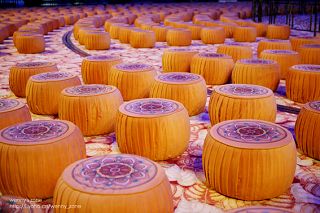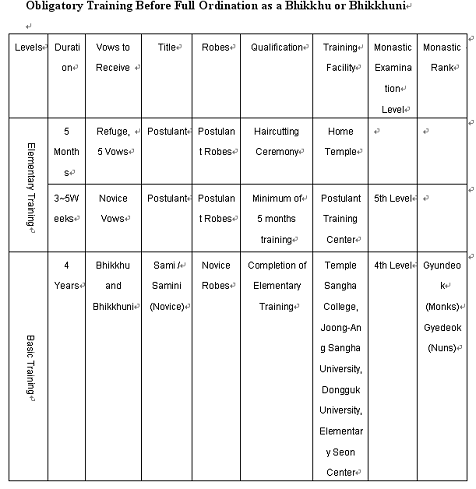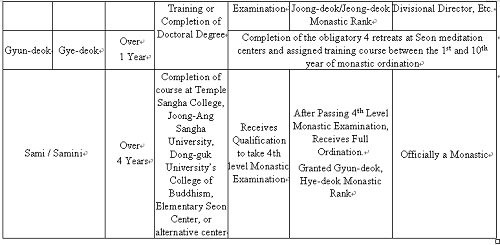Monastic Training System of the Jogye Or
2014/9/5 热度:242
Monastic Training System of the Jogye Order of Korean Buddhism Ven. Pupchin Dean of The goal of the pursuit of the Tripitaka (the three baskets of Vinaya, Sutra, and Abidharma) and application of the three trainings (ethics, meditation, and wisdom) is to accurately understand and apply the principles of Buddhism in actuality. From this point, it is not an exaggeration to say that education and application are everything to the Buddhist practitioner’s life. Here education refers to correctly understanding Buddhist concepts and application refers to actualization. Because it is considered that only by properly understanding Buddhist concepts, can we approach the path of correct understanding and education, and that only by taking into account the actual situation can we practice the Paramitas and be innovative. Accordingly, education and application are synonymous with understanding and actualization. In order to embody these virtues, what are the Jogye Order of Korean Buddhism’s completion requirements within the training and practice system? Together with marrying monks and non-marrying monks, the Jogye Order was officially registered in 1962 with the Korean government’s Ministry of Culture and Public Information. It became the sole order to officially inherit the 1600-year-old tradition of Korean Buddhism. As such, we can understand that the Jogye Order’s practice and training system is the status of Korean Buddhism. This text is an attempt to organize and concisely introduce Jogye Order’s monastic training and practice system, and the new direction for which the Jogye Order is working toward. Training System Summary Jogye Order’s training system can be broadly classified as: 1) Elementary Training, 2) Basic Training, 3) General Training (specialized training), 4) Re-training. First is the postulant (hangja) training for a minimum of six months. Second is the four years of training for novices (shramanera/shramanerika or Sami/Samini) undertaken at temple Sangha colleges, Dongguk University’s College of Buddhism, Joong-Ang Sangha University, or elementary Seon(Zen) centers. These first two trainings must be completed by all Jogye monastics without exception. When the “elementary training” is completed, one can become a novice monastic (Sami/Samini). When the “basic training” is completed, one can take the full monastic vows, and attains the qualification and rights of being a Jogye Order monastic. Third is “general training” where a monastic can pursuit specialized training after receiving full monastic ordination. Fourth is the “re-training” for monastics who have been ordained 5, 10, 20, and 25 years. This is not obligatory, but it is the training process necessary to carry out certain responsibilities as set out by the order, and to hold positions in the order, as well as train disciples. The following charts illustrates the training system. Elementary Training Postulant (Hangja) Registration The monastic prospects put aside their past lifestyle, to begin life as a renunciate at a new and unfamiliar temple. There is a need for the elder monastics to show exceptional interest, consideration, and guidance, so that the postulants acclimate well to temple life and correctly pursuit the monastic path. The temple’s elder monks, while living together with the postulants, must observe whether they have what it takes to make future monastics by thoroughly examining the postulant’s resume, maturation process, past awards and reprimands, family situation, and health history. After closely observing the attitude and behavior of the postulants to determine that they have the sincere motivation of a renunciate, only then are they allowed to stay as postulants. The postulant who has taken the first step, must choose a vocation master (Unsa Sunim) that will lead them, and guide them properly as practitioners. Once the vocation master is selected, the relationship cannot be cancelled without mutual agreement. Therefore, this selection should be done cautiously. The vocation master must have been ordained for at least 10 years, is over 30 years old, passed the third level monastic examination, and is at least a fourth stage monastic. Hair-cutting Ceremony and Postulant Robes Hair-cutting ceremony is meaningful because it officially confirms the postulant as a member of the order. Therefore, this is a formal ceremony, which follows ceremonial procedure with the monastic community in attendance. After this ceremony, the male postulants wear the brown robes and the female postulants wear orange robes. Admission into the Postulant Training Course The postulant’s qualifications are: high school graduate, over 15 years old, and under 50. Once the postulant is trained at the home temple for at least five months, he/she enters the group postulant training course. The main contents of the training course are: novice vows, the “Admonitions to beginners” text, life of Buddha, elementary doctrine, and Buddhist ceremonies. After the completion of the training course, by passing the fifth level monastic examination, the postulant takes the Shramanera/Shramanerika (Sami/Samini) vows and becomes a novice. Basic Training Basic Training Summary Basic training is required training that can be considered the most important among all the training programs and contents. Here the novice cultivates the basic knowledge that a fully ordained Bikkhu or Bikkhuni must possess. This four-year training takes place at the There are 13 The curriculum among these various “basic training” facilities varies more or less, but the As a reference, the following is the l 1st Year: The Buddhist Person I, the Buddhist Person II, Vinaya, Hinayana Buddhism, Abhidharma, History of Indian Buddhism, Understanding Western Philosophy II, Literature I, Literature II, English, Japanese l 2nd Year: Understading the Prajnaparamita Sutra (Diamond Sutra, Heart Sutra, Vimila-kirtinirdesa Sutra, 8000 Poems of the Prajnaparamita Sutra, Understanding Avatamska Sutra, Introduction to the Avatamska school, History of Chinese Buddhism, Understanding Western Philosophy II, Literature III, Literature IV l 3rd Year: “Awakening faith in the Mahayana,” Shuramgama Sutra, Lotus Sutra, Nirvana Sutra, History of Korean Buddhism, Buddhism Overview I, Buddhism Overview II, Literature V, Buddhist Culture, Buddhist Ceremony l 4th Year: Seon Texts (Platform Sutra, Entrance to Sudden Enlightenment, Selected Letters of Master Dahui, Essence of Seon), History of Seon ideology, Buddhism Overview I, Buddhism Overview II, Graduation Thesis When the “basic training” is completed, the novice can take the 4th level monastic examination. If the test is passed, the novice can receive full ordination of a Bhikkhu or Bhikkhuni. General Training Specialized Training Jogye Order’s “specialized training” takes place in Seon meditation centers, Sangha graduate colleges, Vinaya schools, specialized Sangha colleges, etc. Over 2000 Jogye Order monastics in more than 90 Seon meditation centers are keeping the traditional practice custom by practice Seon meditation during the summer and winter retreat seasons. There are two Sangha graduate colleges (one for Bhikkhu, one for Bhikkhuni). Here the specialized and systematic pursuit of scriptures and studies takes place. Future professors and specialized abilities are cultivated at these colleges. Specialized Sangha colleges were created for the systematic education specialized scriptures or text that fits a temple’s tradition and character. Vinaya Schools provide systematic Vinaya education. Goal of the Vinaya Schools is to transmit correctly the monastic traditions and customs, and to prepare the monastics that will transmit the Vinaya. Extracurricular Training The goals of “extracurricular training” are the cultivation of Buddhist arts such as Buddhist culture, Buddhist art, Buddhist music (modern and traditional), Buddhist architecture, and to strengthen the ability to propagate the Dharma. Another goal is to strengthen specialized training in the fields of Broadcast and Print Journalism that is necessary for Dharma propagation. In addition, there is a School of Buddhist Ceremonial Song and Dance with a two-year course. Re-training Education Course Once a Jogye Order monastic has been ordained 20 or 25 years, the monastic must complete the education course that falls under “re-training.” Through this training, the monastic cultivates the character of a religious leader, is granted an opportunity to strengthen the bond with the other monastics participating in the education course, and is supplied with diverse information to acclimate with the modern changing times. Monastic Examination and Monastic Rank According to the ordination age, the Jogye Order monastic must complete the corresponding training. After the training, the monastic takes the examination. After passing the examination, the monastic is endowed with the corresponding monastic rank. The following chart illustrates the monastic ranking system:







电脑上扫描,微信中长按二维码,添加阿弥陀佛平台公众号
五明学习: 五福文摘: 佛教入门 | 历史传记 | 身心灵 | 生活艺术 | 人与自然 | 人文杂话 | 其它 | 素食起步 |